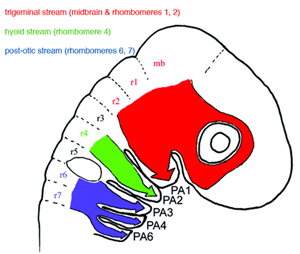Embryology - Biology 104, Spring 2006 - Albert Harris and Corey Johnson
TWENTIETH LECTURE - March 6, 2006, by Corey Johnson
Endoderm Development
The Trachea and Lungs:
The lung starts as a dorsal evagination, from the pharynx: the laryngotracheal diverticulum. The end of the bud branches forming two lung buds. As the lung buds grow, they repeatedly branch forming first the branches of the bronchi. The terminal buds are the alveoli where gas exchange takes place. Only the lining of the respiratory system is endodermal; the muscles, connective tissue, cartilage, and blood vessels are from splanchnic mesoderm. FYI, the thymus forms as a ventral diverticulum from this region of the pharynx.
The Pharynx:
The pharynx is bounded by the fused pharyngeal arches, laterally and ventrally. The so-called pharyngeal pouches, which look like evaginations of the foregut, are the widest regions of the pharynx in between the pharyngeal arches. The embryo has on the outside of the embryo, corresponding ectodermal regions of invagination known as pharyngeal clefts. In animals with gills, the pouches and clefts break through for the passage of water, and the arches develop into gills.
-
1) Openings to the exterior: The end of the foregut approaches the ectoderm as it extends anteriorly. An invagination of the ectoderm, known as the stomadeum, is induced by this proximity. The two blind ended pockets make contact with one another and eventually break through creating an opening from the outside of the embryo, into the gut. At the posterior end, a similar occurrence results in the formation of the proctodeum that breaks through to the hindgut. Both the stomadeum and proctodeum are lined with ectoderm.
Head and Neck Development
The head and neck develop differently from the rest of the embryo, so they are here given special attention. The reason their development is different is because:
-
2) There are no somites in the head, but there is paraxial mesoderm
3) There is little lateral plate mesoderm in the head
4) There is a lot of neural crest that forms structures that it does not otherwise produce in the rest of the body
5) The head is not patterned the same way as the rest of the body. Hox genes don't extend to all of the head. Segmentation is found in the neck but it is not found in the head (morphologically).
The neural crest forms most of the mesenchyme in the head and neck. After neurulation (or during, in the case of mammals) the neural crest leaves the edges of the neural folds and migrates. Several swellings of neural crest form the face as the eyes are moved medially: animation
These tissues become the bones of the face. The face and skull are derived entirely (we think) from neural crest cells since there are no dermatomes. The exception is the very base of the skull, which comes from the dermatomes of the first pairs of somites.

The derivatives of the pharyngeal arches
The mesenchyme of the arches produces several bones, including the mandible and the middle ear bones. The cartilages of the larynx are also derived from the arches.The endoderm and mesoderm combine forming the tonsils, thymus, parathyroid and auditory (Eustachian) tubes and tongue.